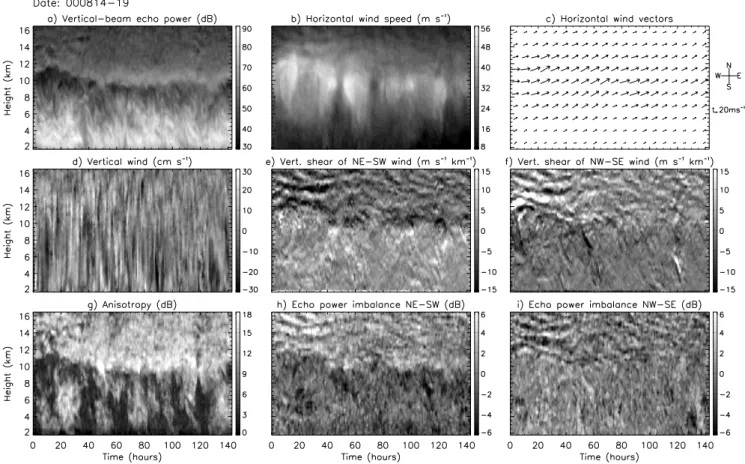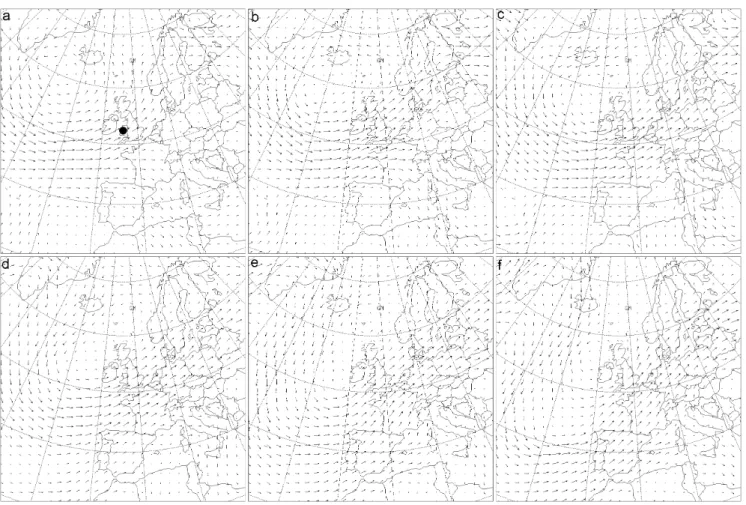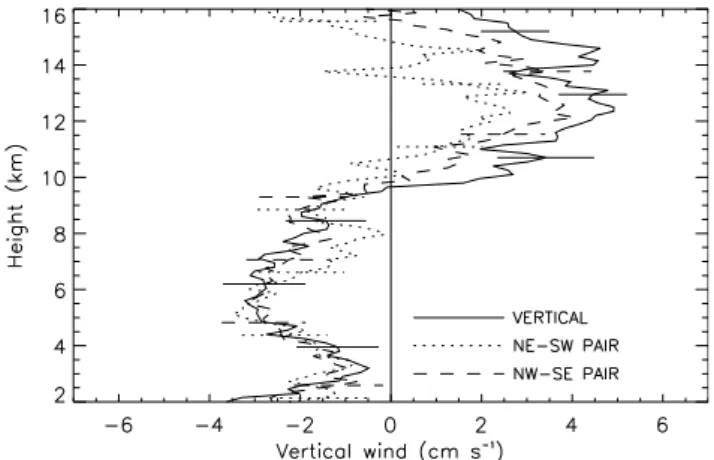HAL Id: hal-00316885
https://hal.archives-ouvertes.fr/hal-00316885
Submitted on 1 Jan 2001
HAL is a multi-disciplinary open access
archive for the deposit and dissemination of
sci-entific research documents, whether they are
pub-lished or not. The documents may come from
teaching and research institutions in France or
abroad, or from public or private research centers.
L’archive ouverte pluridisciplinaire HAL, est
destinée au dépôt et à la diffusion de documents
scientifiques de niveau recherche, publiés ou non,
émanant des établissements d’enseignement et de
recherche français ou étrangers, des laboratoires
publics ou privés.
Asymmetry of atmospheric microstructure over synoptic
scales
R. M. Worthington
To cite this version:
R. M. Worthington. Asymmetry of atmospheric microstructure over synoptic scales. Annales
Geo-physicae, European Geosciences Union, 2001, 19 (8), pp.921-924. �hal-00316885�
Annales
Geophysicae
Asymmetry of atmospheric microstructure over synoptic scales
R. M. Worthington
Co-operative Institute for Research in Environmental Sciences (CIRES), University of Colorado, Boulder, CO 80309-0216, USA
Present address: RASC, University of Kyoto, Uji, Kyoto 611-0011, Japan
Received: 18 October 2000 – Revised: 20 February 2001 – Accepted: 22 March 2001
Abstract. Distortions are often seen in the angular
distri-bution of echo-power from VHF wind-profiling radars, sug-gesting that thin stable layers, within the air flow, are dis-torted and tilted from horizontal. In vertical shear of the hor-izontal wind, the distribution of the layer tilt angles becomes skewed. A case study using six days of VHF radar data and synoptic charts above western Europe indicates that this asymmetry of atmospheric microstructure can exist through-out the troposphere and lower stratosphere, above and below the jet wind maximum, over horizontal scales of thousands of kilometres.
Key words. Meteorology and atmospheric dynamics
(mid-dle atmosphere dynamics; synoptic-scale meteorology; tur-bulence).
1 Introduction
VHF wind-profiling radars often show interesting effects in which the angular distribution of their echo-power is tilted and/or distorted (e.g. Worthington et al., 2000). This can occur when atmospheric gravity waves, including mountain waves, tilt fine-scale VHF-reflective scattering layers (e.g. Dalaudier et al., 1994) from horizontal direction. Also, the echo-power distribution is skewed in regions of vertical shear of horizontal wind (hereafter referred to as ‘shear’). This skewing implies that the average distribution function of scat-tering-layer tilt angles, although often centred close to hor-izontal and giving maximum echo-power from a vertical-pointing VHF beam, is similarly skewed or asymmetric (Wor-thington et al., 1999a,b). Sometimes these two effects of gravity waves and shear are seen together. The observations can also sometimes be interpreted in terms of anisotropic tur-bulence.
The skewing of echo-power in shear may be explained if the majority of scattering layers remain horizontal on
aver-Correspondence to: R. M. Worthington
(worth@kurasc.kyoto-u.ac.jp)
age, but a fraction can become tilted where localised wind shears cause Kelvin-Helmholtz instabilities (KHI) and/or a steepening of other gravity waves (e.g. Worthington et al., 1999a). Cross sections through very large-scale, well-defined KHI billows have been shown by many authors, e.g. James and Browning (1981). Even decaying remnants of KHI show an asymmetry in the tilt angles of atmospheric microstructure (Werne and Fritts, 1999, cover illustration). The sign and magnitude of the VHF echo-power variations have, in earlier studies, been shown to be consistent with a KHI type expla-nation (Worthington and Thomas, 1997; Worthington et al., 1999b).
Historically, effects of tilted fine-scale atmospheric layers have also been studied for radar propagation parallel, not per-pendicular, to the layers (Waterman and Strohbehn 1963), with applications to line-of-sight microwave links. Effects of tilted specular scatterers are considered also by Metcalf and Atlas (1973) and Metcalf (1975), for FM-CW radar. A few studies report aspect sensitivity for wavelengths much smaller than that of VHF radar (e.g. Metcalf, 1975; Kallis-tratova and Petenko, 1993), implying that atmospheric mi-crostructure may be slightly anisotropic on scales as small as centimetres.
It is not known whether the asymmetry of atmospheric microstructure implied by the VHF radar measurements is mainly a curiosity, or if there is any real greater significance. Worthington and Thomas (1997) studied only the effect of shear in lower-stratospheric inertia-gravity waves. However, asymmetry of microstructure and of VHF echo-power maps is not restricted to these waves; only a combination of shear and VHF-aspect-sensitive air is required. Therefore, this short paper considers, over synoptic scales, how widespread can be the asymmetry of VHF power distribution, and hence of atmospheric microstructure.
2 Observations
Figure 1 shows six days of data from the Aberystwyth VHF radar (located 52.42◦N, 4.00◦W, frequency 46.5 MHz,
922 R. M. Worthington: Asymmetry of atmospheric microstructure over synoptic scales
Fig. 1. Height-time plots of (a) vertical-beam echo-power, showing the tropopause height near 9-11 km, (b) horizontal wind speed, (c)
hori-zontal wind vectors, (d) vertical wind component measured by averaging radial velocities from 2 pairs of symmetric beams 6◦off-vertical,
(e) vertical shear of the horizontal wind component measured by the symmetric pair of beams at 6◦off vertical, aligned approximately NE–SW (N26◦E–S26◦W), (f) same as (e) for the beam pair aligned approx. NW–SE (N64◦W–S64◦E), (g) difference between vertical and average 6◦echo powers to show the VHF aspect sensitivity of the air, (h) echo-power imbalance between the symmetric pair of beams aligned NE–SW, (i) same as (h) for the beam pair aligned NW–SE. The echo-power imbalances in (h) are the central observations in the paper.
height resolution 300 m, beam width 3◦). This case study is selected from several thousand days of almost continuous data, and it is fairly typical of measurements from this site.
Southwesterly jet stream winds are above the radar, Fig. 1b, c, with shear throughout the troposphere and lower strato-sphere. The shear reverses direction at about 9 km height, as shown in Fig. 1e. Similarly, there is an echo-power im-balance in Fig. 1h, at all heights and for all six days, also reversing sign at about 9 km. The VHF backscatter is as-pect sensitive (anisotropy not close to zero) in Fig. 1g during most of the six days. The tropopause, shown by echo-power in Fig. 1a (see e.g. Fig. 1b of Worthington, 1998), is near the 9–11 km height.
Since the horizontal wind and shear in the troposphere are both toward the northeast (NE) azimuth, it would be ex-pected (e.g. Fig. 7 of Worthington and Thomas, 1997) that the radar beam pointing upwind, toward SW, receives higher echo-power, as is observed. Much less imbalance between symmetric beams is seen in the orthogonal NW-SE azimuth (Fig. 1i).
During the six days of data, the asymmetry of atmospheric
microstructure implied by the echo-power imbalance could be present in a large volume of atmosphere, advected above the radar. To put the radar results into larger-scale context, Fig. 2 shows wind vectors at 500 mb above western Europe, centered on the radar location. Data are from the final (FNL) runs of the NCEP Global Data Assimilation System (GDAS) model. Sequences of charts at other levels are qualitatively similar. The horizontal wind in Fig. 1b, c, measured at only a single location, is seen to be part of a jet stream that re-mained in a fairly fixed position relative to the radar for all six days. The effect of shear on echo-power is very repeat-able (e.g. Fig. 6 of Worthington and Thomas, 1997), and there is nothing unusual about the radar location relative to the jet stream structure in Fig. 2. Therefore, hypothetically, if measurements of upward-looking VHF backscatter could be made across the entire region of Fig. 2, there is no reason that the asymmetry of atmospheric microstructure indicated by Fig. 1h would not also be found over large horizontal areas near the jet, implying that there are regions close to instabil-ity throughout synoptic-scale volumes of atmosphere.
Fig. 2. Horizontal wind vectors at 500 mb above western Europe, at 12 UTC on (a) 14, (b) 15, (c) 16, (d) 17, (e) 18, (f) 19 August 2000. The
maximum vector length is 30 m s−1. In (a), a dot marks the radar location.
only inferred indirectly from radar, but it might be possi-ble to study them in situ. For instance, Thorpe and Lemmin (1999) used lines of horizontally-spaced temperature sensors to study instabilities of internal gravity waves in a large lake. Histograms of temperature time-derivatives were not sym-metric about zero, and this was interpreted as evidence for steepened internal waves. An analagous atmospheric exper-iment might use histograms of temperature time-derivative, measured from an aircraft flying horizontally, in shear above and below the jet stream. The flight should be parallel to the jet stream wind, since this would often be parallel to the shear vector as well, except within any inertia-gravity waves in the lower stratosphere (Worthington et al., 1999b). The asymmetry or skewing of the histograms of the temperature time-derivative is predicted to change sign, from above to below the jet maximum. Histograms of time derivatives of radar parameters, perhaps vertical-beam echo-power, could also be studied, but this remains to be explored. A similar method, but using, for example, acoustic radar in the convec-tive boundary layer, is shown by Quintarelli (1990).
Muschinski (1996) suggests, theoretically, that an asym-metry of metre-scale atmospheric structure, as in Fig. 1h, could bias measurements of mean vertical wind (W ) by VHF radar. The effects of mountain waves are, however,
diffi-cult to remove (Worthington et al., 2001), and there may be weak mountain waves in Fig. 1d. Figure 3 shows pro-files of W averaged over all six days, with W downward in the troposphere and upward in the stratosphere. The agree-ment between different beam combinations in Fig. 3 is not expected for the Muschinski (1996) model, but supports a main contribution from the mountain-wave effect discussed by Worthington et al. (2001). Nevertheless, although moun-tain waves significantly affect W in Fig. 3, the average tilt of their streamlines (of order tan−1(W /U ), where W and U
are average vertical and horizontal wind components) is only about 0.1◦. Assuming a typical echo-power gradient of a few dB per degree of zenith angle, a 0.1◦ tilt is insufficient to explain the ∼2 dB magnitude (or the sign) of echo-power imbalance, leaving just the KHI model to explain Fig. 1h.
3 Conclusions
Measurements by a VHF wind-profiling radar show that asymmetry or skewing in the angular distribution of echo-power can be observed throughout the entire troposphere and lower stratosphere, for six days, in a fairly typical case study. Using synoptic maps, the jet stream wind structure, which
924 R. M. Worthington: Asymmetry of atmospheric microstructure over synoptic scales
Fig. 3. Profiles of mean vertical wind W during 14–19 August 2000,
using the vertical beam and two symmetric pairs of beams at 6◦off vertical. Standard errors on the means are plotted.
causes this effect, is seen to extend over much of western Eu-rope. Since the skewing of echo-power occurs predictably in conditions of VHF aspect sensitivity and wind shear, the im-plied asymmetry of atmospheric microstructure may extend over a horizontal scale of thousands of kilometres. Further significance, and in situ verification remain to be explored.
Acknowledgements. Figures 2a-f are supplied by the NOAA Air Resources Laboratory. The Aberystwyth radar is a facility of the U.K. Natural Environment Research Council. RMW is supported now by a fellowship from Japan Society for the Promotion of Sci-ence.
Topical Editor J. P. Duvel thanks A. Muschinski for his help in evaluating this paper.
References
Dalaudier, F., Sidi, C., Crochet, M., and Vernin, J., Direct evidence of “sheets” in the atmospheric temperature field, J. Atmos. Sci., 51, 237–248, 1994.
James, P. K. and Browning, K. A., An observational study of pri-mary and secondary billows in the free atmosphere, Quart. J.
Roy. Meteorol. Soc., 107, 351–365, 1981.
Kallistratova, M. A. and Petenko, I. V., Aspect sensitivity of sound backscattering in the atmospheric boundary layer, Appl. Phys. B, 57, 41–48, 1993.
Metcalf, J. I. and Atlas, D., Microscale ordered motions and atmo-spheric structure associated with thin echo layers in stably strat-ified zones, Boundary-Layer Meteorol., 4, 7–35, 1973.
Metcalf, J. I., Microstructure of radar echo layers in the clear atmo-sphere, J. Atmos. Sci., 32, 362–370, 1975.
Muschinski, A., Possible effect of Kelvin-Helmholtz instability on VHF radar observations of the mean vertical wind, J. Appl. Me-teorol., 35, 2210–2217, 1996.
Quintarelli, F., A study of vertical velocity distributions in the plan-etary boundary layer, Boundary-Layer Meteorol., 52, 209–219, 1990.
Thorpe, S. A. and Lemmin, U., Internal waves and temperature fronts on slopes, Ann. Geophysicae, 17, 1227–1234, 1999. Waterman, A. T. and Strohbehn, J. W., Reflection of radio waves
from undulating tropospheric layers, J. Res. National Bureau Standards, D–Radio prop., 67D, 609–616, 1963.
Werne, J. and Fritts, D. C., Stratified shear turbulence: Evolution and statistics, Geophys. Res. Lett., 26, 439–442, 1999.
Worthington, R. M., Tropopausal turbulence caused by the breaking of mountain waves, J. Atmos. Solar-Terr. Phys., 60, 1543–1547, 1998.
Worthington, R. M. and Thomas, L., Long-period unstable gravity-waves and associated VHF radar echoes, Ann. Geophysicae, 15, 813–822, 1997.
Worthington, R. M., Muschinski, A., and Balsley, B. B., Bias in mean vertical wind measured by VHF radars: Significance of radar location relative to mountains, J. Atmos. Sci., 58, 707–723, 2001.
Worthington, R. M., Palmer, R. D., and Fukao, S., Complete maps of the aspect sensitivity of VHF atmospheric radar echoes, Ann. Geophysicae, 17, 1116–1119, 1999a.
Worthington, R. M., Palmer, R. D., and Fukao, S., An investigation of tilted aspect-sensitive scatterers in the lower atmosphere using the MU and Aberystwyth VHF radars, Radio Sci., 34, 413–426, 1999b.
Worthington, R. M., Palmer, R. D., Fukao, S., Yamamoto, M., and Astin, I., Rapid variations in echo power maps of VHF radar backscatter from the lower atmosphere, J. Atmos. Solar-Terr. Phys., 62, 573–581, 2000.


